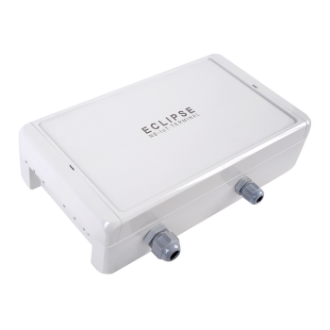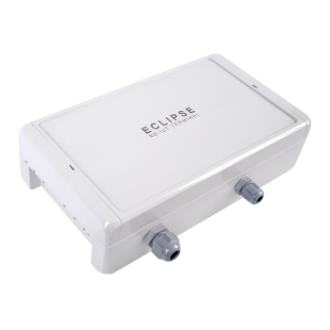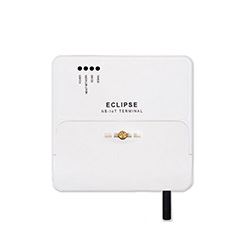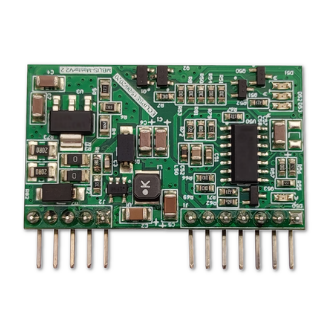
Battery Operated IP68 Cat M1 Gateway | ECL-GW-T18-CM1-BOWP

ECL-GW-T18-CM1-BOWP is a state of the art Battery Operated LTE M Gateway designed mainly for use in remote water meter reading applications where no mains supply is available at the installation location.
It can be provided with Wired M-Bus, Wireless M-Bus and Pulse Counter options.
Its software can be customized and be adapted to different reading standards, meter brands, models, data processing scenarios and data formats that can be requested by Head-End Systems and can be easily updated over the air in a secure manner.






SPECIFICATIONS
- Size: 231 x 125 x 60 mm
- Weight: ~500 grams (without batteries)
- IP68 Enclosure
- Flame retardant (UL94V-0)
- Wall Mounting
- -35 … +75°C operating temperatur
- -40 … +85°C storing temperature
- 3.6V Lithium Battery
- MB1 & WMB1 Variants: 52AH total capacity
- PULSE Variant: 52AH total capacity
- Up to 10 year(*) life-time depending on usage
- Cat M1:
B1/B2/B3/B4/B5/B8/B12/B13/B14/B18/B19/B20/B25/B26/B27/B28/B66/B85 - Cat NB2:
B1/B2/B3/B4/B5/B8/B12/B13/B18/B19/B20/B25/B26/B28/B66/B71/B85 - GSM/EDGE: 850/900/1800/1900 MHz
- Data Transmission:
Cat M1: Max. 588Kbps (DL), Max.1119Kbps (UL)
Cat NB2: Max. 127Kbps (DL), Max.158.5Kbps (UL)
EDGE: Max. 296Kbps (DL) Max.236.8Kbps (UL)
GPRS: Max. 107Kbps (DL) Max. 85.6Kbps(UL) - Protocol Stacks: IPv4 IPv6 UDP TCP MQTT
- Point-to-point MO and MT
- PDU Mode
- Cat M1, NB2, NB1 according to 3GPP Rel.14
- USIM × 1: Supports 1.8/3.0 V USIM Card
- Maximum Output Power:Power Class 5 21 @ LTE Bands
- Power Consumption: Cat M1
Sleep Mode: 1.65 @ DRX = 1.28 s
0.63 @ e-IDRX =81.92 s
Idle Mode: 18.9 @ DRX = 1.28 s
18.2 @ e-I-DRX = 81.92 s
Active Mode: 199 @ 21 dBm, GNSS of
- DFOTA: Delta Firmware Upgrade Over-The-Air
- RAI: Release Assistance Indication
- ECID: Enhanced Cell ID
- OTDOA: Observed Time Difference of Arrival
- GCF (Global)
- CE (Europe)
- Anatel (Brazil)
- KC (South Korea)
- NCC (Taiwan, China)
- JATE/TELEC (Japan)
- RCM (Australia/New Zealand)
- NBTC (Thailand)
- IMDA (Singapore)
- Others: RoHS Compliant ATEX (Europe)
- ARM Microprocessor (32-bit ARM® Cortex®-M4 120Mhz 1Mbyte Flash)
- Real Time Clock (RTC)
- Built In Flash Memory (4Mbyte)
- Hardware Watchdog
- LED Status Indicators IPv4, IPv6, UDP, CoAP, LwM2M, Non-IP, DTLS, TCP protocol stacks
- Can send last-gasp message to server in case of power cut-off with help of Super Capacitors
- SMA Female Antenna Connectors
- CE Certified
- WMB1 – Wireless M-Bus Module (1 Slave)
(Alternative to Wired M-Bus)
433 or 868 MHZ Operation
1500 meters line of sight
TX at +10 dBm: 13.4 mA
Receiver Sensitivity –124 dBm
Long-Range Mode, –110 dBm at 50 kbps
Selectivity (±100 kHz): 56 dB
Blocking Performance (±10 MHz):90 dB
Programmable Output Power up to +15dBm - MB1 – Wired M-Bus Module (1 Slave)
(Alternative to Wireless M-Bus)
1.5mA Idle Mode Current Supply Per Slave
Overload protection
Cable length can be up to 10 km
Up to 19200 bps communication - PULSE – Pulse Counter Interface Can connect to pulse adapters for
conventional mechanical water meters to account forward
RELATED PRODUCTS
Battery Operated IP68 NB-IoT Gateway ECL-GW-T18-NB-BOWP
ECL-BC95-T1 builds a transparent communication platform between field devices via serial ports and remote servers or applications over cellular networks.
ECL-BC95G-T6 builds a transparent communication platform between field devices via serial ports and remote servers or applications over cellular networks.
ECL-BC66-T3 builds a transparent communication platform between field devices via serial ports and remote servers or applications over cellular networks.






